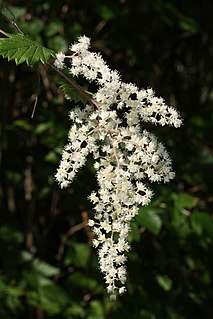
Holodiscus discolor, commonly known as ocean spray or oceanspray, creambush, or ironwood, is a shrub of western North America.

Ripogonum is a genus of flowering plants confined to eastern Australia, New Zealand, and New Guinea. Until recently this genus was included in the family Smilacaceae, and earlier in the family Liliaceae, but it has now been separated as its own family Ripogonaceae.
Supplejack is a common name for several plants and may refer to:

Rubus armeniacus, the Himalayan blackberry or Armenian blackberry, is a species of Rubus in the blackberry group Rubus subgenus Rubus series Discolores Focke. It is native to Armenia and Northern Iran, and widely naturalised elsewhere. Both its scientific name and origin have been the subject of much confusion, with much of the literature referring to it as either Rubus procerus or Rubus discolor, and often mistakenly citing its origin as western European. Flora of North America, published in 2014, considers the taxonomy unsettled, and tentatively uses the older name Rubus bifrons.

Faurea is a genus containing 15 species of flowering plants in the protea family which occur in the summer rainfall area of southern Africa, extending to tropical Africa and Madagascar. The name honours South African soldier and botanist William Caldwell Faure (1822-1844) who was killed on active service in India.

Leucadendron discolor is a species of plant in the family Proteaceae. It is endemic to South Africa. It is threatened by habitat loss. In English the plant is known as the Piketberg Conebush and in Afrikaans as the Rooitolbos. L. discolor is a slow growing perennial. Growth of the root system and propagation, from a seed to the plant's first flower, can take up to two years. The male L. discolor 'Sunset' flowers exuberantly during early spring exposing a colorful flowerhead during this time.The flower head is composed of a dome-like receptacle, and is densely covered with small male flowers. These plants are only able to reproduce after their third year of life.

Ptisana salicina, or king fern, is a species of fern native to Australia, New Zealand and the South Pacific. Large and robust with a distinctive tropical appearance, it has fronds up to 5 metres tall that arise from a starchy base that was a traditional food for the Maori. It has several other common names including para, tawhiti-para, and horseshoe fern.
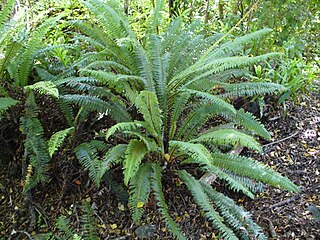
Lomaria discolor, synonym Blechnum discolor, commonly called crown fern, is a species of fern in the family Blechnaceae. This species is endemic to New Zealand. As noted by C. Michael Hogan, this species is found in a number of forest communities in diverse locations within New Zealand, and is sometimes a dominant understory component.

Leptecophylla juniperina is a species of flowering plant in the family Ericaceae. The species is native to New Zealand and the Australian states of Tasmania and Victoria. The plant's fruit is edible, raw or cooked. Plants grow best in areas with moderate winters and cool moist summers.

Zealandia pustulata, synonym Microsorum pustulatum, is a species of fern within the family Polypodiaceae.

Dendroconche scandens, synonym Microsorum scandens, commonly called fragrant fern, is a species of fern within the family Polypodiaceae. This species is native to parts of New Zealand and Australia, as well as some offshore islands. It has been introduced to South Africa and Zimbabwe. An example occurrence in New Zealand's North Island is in the Hamilton Ecological District where it is associated with a number of other ferns including Icarus filiforme and Lomaria discolor.

Dendrobium discolor, commonly known as antler orchids, are epiphytic or lithophytic orchids in the family Orchidaceae. They have cylindrical pseudobulbs, each with between ten and thirty five leathery leaves, and flowering stems with up to forty mostly brownish or greenish flowers with wavy and twisted sepals and petals. Antler orchids occur in northern Australia, New Guinea and Indonesia and there are several subspecies and varieties.
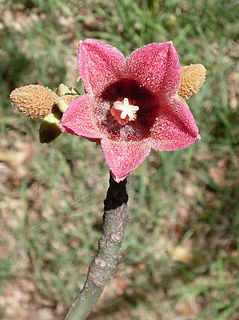
Brachychiton discolor is a rainforest tree of eastern Australia. It grows in drier rainforest areas. Scattered from Paterson, New South Wales to Mackay, Queensland. There is also an isolated community of these trees at Cape York Peninsula. And they have been known to grow in southern areas of California.

Endiandra discolor is an Australian tree, growing from near Gosford, New South Wales to Tully, Queensland in the tropics. Common names include rose walnut and domatia tree.
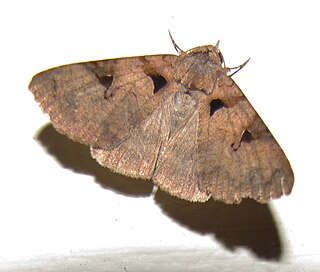
Avatha discolor is a species of moth of the family Erebidae. It is found from the Indo-Australian and Pacific tropics to as far east as Henderson Island.
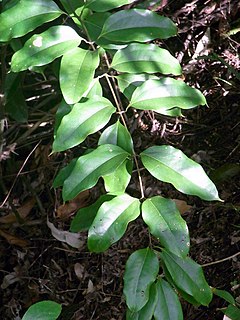
Ripogonum album, known as the white supplejack, is a common rainforest vine, found in eastern Australia. The leaves are identified by the longitudinal venation. A stout climber, with stems up to 15 metres long. Flowers are greenish white, and the fruit is a round red berry. Indigenous Australians used the stems for making traps for catching crayfish.
Ripogonum brevifolium, commonly known as small–leaved supplejack, is a vine, or sometimes a shrub, native to Australia.
Ripogonum elseyanum, commonly known as hairy supplejack, is a climbing vine, or sometimes a shrub, native to coastal rainforests of New South Wales and Queensland, Australia.
Ripogonum fawcettianum, commonly known as small supplejack, is a small climbing vine, or sometimes a shrub, native to coastal rainforests of New South Wales and Queensland, Australia.
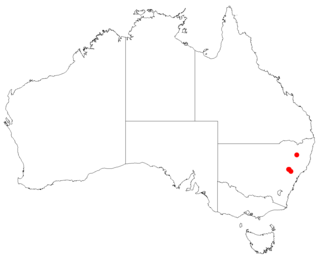
Prostanthera discolor is a species of flowering plant in the family Lamiaceae and is endemic to a small area of New South Wales. It is an open, erect, strongly aromatic shrub with lance-shaped to oblong leaves, and deep mauve to purple flowers with darker spots inside.
















